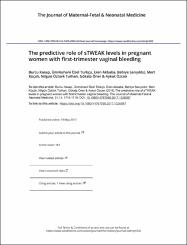| dc.contributor.author | Kasap, Burcu | |
| dc.contributor.author | Türkcü, Ümmühani Özel | |
| dc.contributor.author | Akbaba, Eren | |
| dc.contributor.author | Sarıyıldız, Behiye | |
| dc.contributor.author | Küçük, Mert | |
| dc.contributor.author | Turhan, Nilgün Öztürk | |
| dc.contributor.author | Özcan, Aykut | |
| dc.date.accessioned | 2020-11-20T14:51:10Z | |
| dc.date.available | 2020-11-20T14:51:10Z | |
| dc.date.issued | 2018 | |
| dc.identifier.issn | 1476-7058 | |
| dc.identifier.issn | 1476-4954 | |
| dc.identifier.uri | https://doi.org/10.1080/14767058.2017.1326097 | |
| dc.identifier.uri | https://hdl.handle.net/20.500.12809/1698 | |
| dc.description | WOS: 000430732400007 | en_US |
| dc.description | PubMed ID: 28462593 | en_US |
| dc.description.abstract | Purpose: To investigate the relationships of TNF-related weak inducer of apoptosis (sTWEAK), a cytokine related to the TNF superfamily, its newly described soluble receptor sCD163, and the sTWEAK/sCD163 ratio with perinatal outcomes in women with first-trimester vaginal bleeding.Materials and methods: Seventy (41 threatened abortion and 29 control) gestational-age-matched (6-14weeks) pregnant women were included in the study. Antenatal complications (gestational diabetes, preeclampsia, intrauterine growth restriction, oligohydramniosis, polyhydramniosis), and perinatal outcomes (delivery mode, birth weight, delivery week) were recorded. Women with vaginal bleeding were divided into subgroups by pregnancy outcome (miscarriage or live birth) and subchorionic hematoma incidence. Statistical analyses were performed using the Student's t test, Mann-Whitney U test, chi-square test, and Pearson's correlation coefficient. p Values<.05 were considered as statistically significant.Results: There were no statistically significant differences in sTWEAK or sCD163 levels, in sTWEAK/sCD163 ratios, or antenatal complications between threatened abortion and control patients. Higher sTWEAK levels were significantly correlated with higher rates of miscarriage in the threatened abortion group (p=.014). sCD163 levels were significantly lower in the subchorionic hematoma subgroup of the threatened abortion group (p=.043).Conclusions: sTWEAK levels may predict the risk of miscarriage in pregnant women with first-trimester vaginal bleeding. | en_US |
| dc.item-language.iso | eng | en_US |
| dc.publisher | Taylor & Francis Ltd | en_US |
| dc.item-rights | info:eu-repo/semantics/openAccess | en_US |
| dc.subject | Vaginal Bleeding | en_US |
| dc.subject | Pregnancy | en_US |
| dc.subject | Stweak | en_US |
| dc.subject | Scd163 | en_US |
| dc.subject | Miscarriage | en_US |
| dc.title | The predictive role of sTWEAK levels in pregnant women with first-trimester vaginal bleeding | en_US |
| dc.item-type | article | en_US |
| dc.contributor.department | MÜ, Tıp Fakültesi, Cerrahi Tıp Bilimleri Bölümü | en_US |
| dc.contributor.institutionauthor | Kasap, Burcu | |
| dc.contributor.institutionauthor | Türkcü, Ümmühani Özel | |
| dc.contributor.institutionauthor | Akbaba, Eren | |
| dc.contributor.institutionauthor | Sarıyıldız, Behiye | |
| dc.contributor.institutionauthor | Küçük, Mert | |
| dc.contributor.institutionauthor | Turhan, Nilgün Öztürk | |
| dc.identifier.doi | 10.1080/14767058.2017.1326097 | |
| dc.identifier.volume | 31 | en_US |
| dc.identifier.issue | 13 | en_US |
| dc.identifier.startpage | 1715 | en_US |
| dc.identifier.endpage | 1719 | en_US |
| dc.relation.journal | Journal of Maternal-Fetal & Neonatal Medicine | en_US |
| dc.relation.publicationcategory | Makale - Uluslararası Hakemli Dergi - Kurum Öğretim Elemanı | en_US |


















